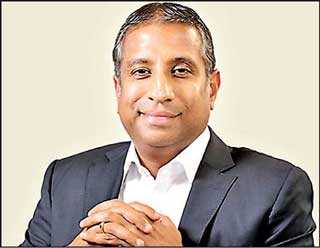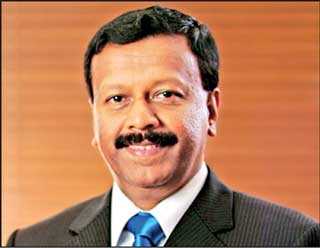Sunday Feb 23, 2025
Sunday Feb 23, 2025
Wednesday, 8 January 2020 00:00 - - {{hitsCtrl.values.hits}}
Microfinance is a major part of LOLC Group’s business and this achievement has come after carefully-crafted strategies, years of experience and expertise, and best practices. In fact LOLC’s microfinance success model has won many global accolades, prompting many to follow suit. However, it regrets demonisation of microfinance by some vested parties as well as ill-informed officials. In a conversation with Daily FT, LOLC Group Deputy Chairman Ishara Nanayakkara and Group Managing Director Kapila Jayawardena take head-on some of the misconceptions of and allegations against microfinance:
Q: What kind of an impact did the Government debt relief program that took place in 2018 have on the microfinance industry? What is your take on it?
Ishara: It is really disheartening to acknowledge the detrimental impact this debt relief program created in the Sri Lankan microfinance industry. First of all, the eligibility criteria did not have a sound rationale,
 |
LOLC Deputy Chairman
|
 |
LOLC Managing Director
|
the industry was never consulted in the planning. It was given only to women, who are residing in 12 districts of specific parts of the country, and for women who had been on default. It raised all these questions: What about the rest of the country? Rest of the customers in other districts? What about male customers? What about those who went that extra mile to honor their payments every month against all odds?
With the announcement of the debt relief program in July 2018, a lot of misinterpretation occurred for political advantage. Some politicians misused the concept for election promises, where they encourage people who pay on time too, to default so that they will be eligible for the debt relief program. This caused confusion and unrest amongst borrowers not just in the 12 districts but across the country, creating massive number of willful defaulters. It created a culture of default that this country never had. I mean Sri Lanka had healthy recovery ratios of over 90% levels in microfinance, which is why we had the attention of many DFIs. The shock this created to the industry and the trickledown negativity is evident to date even after 18 months. And it will take a long term for the industry to recover because it pushed the customer back to the informal lending market as the formal sector was reluctant to increase exposure under these circumstances.
Q: There had been a lot of accusations by the community and even from some reputed media on how NBFIs lead customers to over-indebtedness, to the point where even some fatal incidences have been reported as a result of undue recovery measures by the companies. What are your views on this?
Ishara: First of all, you need to differentiate the markets. The role of microfinance by the formal lenders such as banks and NBFIs are often misunderstood with the repercussions generated by the informal lenders. There are over 35,000 informal lenders in this country and estimates suggest that over 40% of the population has been subjected to it.
People access the informal lending market out of habit, convenience or due to lack of availability by the formal channels as the microfinance segment was largely considered as non-bankable until recently. People borrow from these informal lenders at unbelievable rates and when they cannot service the loans, they lose their assets, income sources and the dignity that leads to irrational decisions. The concept of over-indebtedness stems from this informal lending market which is not regulated, whereas the formal sector is closely monitored by the CBSL, with rate caps in place and responsible lending is encouraged with the involvement of institutions such as CRIB. The NBFI sector has played a pivotal role in eliminating the repercussions created by the informal lenders but is being unreasonably accused due to misconstrued views.
Kapila: As Ishara mentioned, the misinformation circulated in some media about microfinance players in the country is blown out of proportion. Once we took a closer look some of these articles, it became clear that these were published with a small sample size of consumers, highlighting the experiences of a few defaulted micro customers across the board, often with a clear hidden agenda or a political motive. There are, indeed, some reprehensible situations faced by customers who have turned to the informal sector, and there is much to be done in order to regulate this market, but it would not be practical on the part of the government or regulators or any other officials to paint the whole sector with a broad brush.
Ishara: Therefore, what is important is to have a balanced view on the reality. Who is going to scrutinise the positive impact created by this industry? What about all the income sources created? What about empowering all those women/mothers who run the show in the household and now have become the breadwinners? What about the wave of self-made entrepreneurs who directly contributes to the economic activities in the country? Why does not anyone take stock of that?
Q: Tell your side of the story? What is your role in microfinance?
Ishara: Our microfinance model is different to that of conventional microfinance model. So is our social case. In order to comprehend the social case, it is important to understand our microfinance model. We have smaller groups, reasonable loan amounts, and payment patterns that fits best to their cash-flows. We do not hinder the growth of the customer with undue restrictions such as cross guarantees, encouraging them to upscale their eligibility based on the track record. Therefore, our model allows budding micro entrepreneurs to graduate to the SME sector in few loan cycles. Once they become a SME client, they can continue their journey with us, because we are essentially an SME lender from our roots. The model prioritises empowerment of women, widely identified as the most effective route to eradicate poverty and enhance living standards. Because when you help a mother to stand on her own feet, she nurtures the whole family by being the breadwinner, educating children and forming a future. This is the beauty of true empowerment.
This is the reason why our microfinance model has been recognised by many independent international organisations. LOLC Micro Credit Limited (LOMC, now merged with LOLC Finance PLC) was the first Sri Lankan MFI and the 13th in the world to be awarded Client Protection Principles (CPP) Certification from the SMART Campaign (a global initiative which exists to ensure strong client protection practices in the microfinance industry), while LOLC Cambodia PLC was the first organisation in Cambodia to be certified.
CPP is a differentiating factor for us in comparison to our competition. It fundamentally protects the clients from undue interest rates or over charge, makes the customers fully aware of their rights and obligations. Because we are obliged by CPP, we cannot unreasonably charge the customer or change rates as we please like the common industry practices. Thus, to keep up with the competition, we work hard to improve our efficiencies and manage costs. We reaped the benefits of CPP, when both Sri Lankan and Cambodian regulators imposed rate caps, as we were already operating within the parameters while most of our peers faced difficulties.
Our model was also featured as a business case study by INSEAD Business School in their MBA program following an independent study on the Company’s remarkable growth, commitment to empowering women and communities, and outstanding social stewardship reflected in the business model. PRASAC has also been recognised by MIX as a S.T.A.R. MFI whilst both LOFC and LOLC Cambodia are rated the coveted Platinum Grade by the Global Impact Investing Rating system for their impactful business conduct.
Kapila: As a result of our international acclaim and tangible impact on the communities in which we operate, we have been able to foster long-standing relationships with a large array of international funding partners and DFIs, who have been instrumental in raising LOLC’s standards to a global level. This extraordinary role is reinstated by LOLC’s longstanding international funding partners and DFIs such as the Dutch Development Bank – FMO, The French Development Agency-PROPARCO, German Government Agency – DEG and the Asian Development Bank (ADB). With over four dozen international funding partners, with some relationships spanning over 25 years, LOLC has been the entry point to Sri Lanka for most of these lenders. Considering the Group’s ethical business fundamentals, sound financial performance and strong social accord, these multinational lenders use LOLC group as their preferred conduit to achieve their development goals.

Discover Kapruka, the leading online shopping platform in Sri Lanka, where you can conveniently send Gifts and Flowers to your loved ones for any event including Valentine ’s Day. Explore a wide range of popular Shopping Categories on Kapruka, including Toys, Groceries, Electronics, Birthday Cakes, Fruits, Chocolates, Flower Bouquets, Clothing, Watches, Lingerie, Gift Sets and Jewellery. Also if you’re interested in selling with Kapruka, Partner Central by Kapruka is the best solution to start with. Moreover, through Kapruka Global Shop, you can also enjoy the convenience of purchasing products from renowned platforms like Amazon and eBay and have them delivered to Sri Lanka.
Discover Kapruka, the leading online shopping platform in Sri Lanka, where you can conveniently send Gifts and Flowers to your loved ones for any event including Valentine ’s Day. Explore a wide range of popular Shopping Categories on Kapruka, including Toys, Groceries, Electronics, Birthday Cakes, Fruits, Chocolates, Flower Bouquets, Clothing, Watches, Lingerie, Gift Sets and Jewellery. Also if you’re interested in selling with Kapruka, Partner Central by Kapruka is the best solution to start with. Moreover, through Kapruka Global Shop, you can also enjoy the convenience of purchasing products from renowned platforms like Amazon and eBay and have them delivered to Sri Lanka.